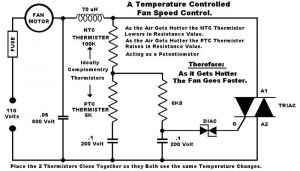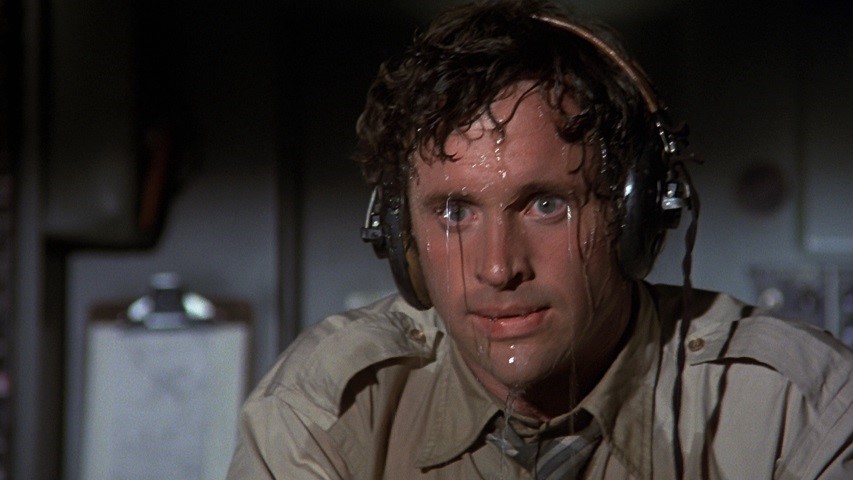
Each winter season across the hemispheres, we see this topic come up again and again, in various online cycling forums and the Zwift Riders Facebook group.
“Do I need a fan while cycling indoors, even when it’s cold inside my workout space?”
We often see people showcasing their “Pain Caves” with beautiful photos, but one thing that is missing from time to time, is the fan, or some other active active cooling system. Do they really need a cooling fan?
The answer is, unequivocally, YES!
The justification on one side of the table is that it’s “cool enough” in their workout space not to need a fan, or that they’re “only working out for 30 minutes at a time”, so why use a fan?
A cooler room just isn’t enough, you have to move the hot air away from your body, off of your skin. Your heart will thank you for reducing the stress it has to bear. Cycling isn’t Bikram Yoga, after all!
The Myths
-
- Myth: As long as the room is cooler, you’re fine. You don’t need any fans.
Fact: Not entirely true. You need to evaporate the perspiration from your skin to lower the body’s temperature as heat increases from riding or working out. If you don’t evaporate the perspiration produced, your body will continue to sweat, and continue to heat up, but it won’t cool down. Moving air across the skin is the fastest way to evaporate any perspiration created, through heat transfer.
- Myth: As long as the room is cooler, you’re fine. You don’t need any fans.
-
- Myth: Sweating alone cools the body down enough, you don’t need a fan. If you want to cool down faster, sweat more!
Fact: Incorrect. Sweating only brings the body’s heat to the surface of the skin in the form of perspiration. It’s the act of evaporative cooling from exhaled perspiration that actually cools the body and brings the temperature down. A room that is cooler than your body’s rising temperature can help evaporation, but you have to be able to evaporate the perspiration faster than you’re producing it, for the effects to work. A fan (or fans) helps accellerate that process.
- Myth: Sweating alone cools the body down enough, you don’t need a fan. If you want to cool down faster, sweat more!
-
- Myth: Teaching your body to work harder in higher temperatures avoids the need for cooling or a fan.
Fact: There’s a very distinct difference between acclimating your body to working out under higher temperatures and over-heating your body by restricting the necessary evaportive effects that moving air across perspiration provides. Your body still needs to “breathe” to cool itself down, to evaporate any accumulated perspiration on the surface of the skin. Block or restrict that, and you’re going to cause harm to your systems.
- Myth: Teaching your body to work harder in higher temperatures avoids the need for cooling or a fan.
- Myth: Drink less and you’ll sweat less, so your body will stay cooler.
Fact: Dangerous advice at any level. The body needs water and fluids packed with electrolytes to replenish what it has lost through exercise. If you’re not drinking, you’re not replenishing what the body needs to function correctly. If you’ve “run out of sweat”, you’re dangerously close to heat stroke and/or dehydration.
The Science
This isn’t just an opinion, it’s backed by science. A lot of science:
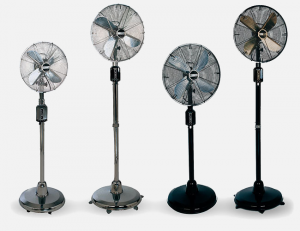
- Evaporation of Perspiration: Cooling Mechanisms for Human Body, HyperPhysics Concepts at Georgia State University
- Exercise, Heat, Hydration, and the Brain. R.J. Maughan, S.M. Shirreffs, and P. Watson. Journal of the American College of Nutrition. October 2007.
- Exercising in the Heat. Dr. Stephen D Ball, Ph.D., Nutrition and Exercise Physiology, University of Missouri Extension.
- ACSM position stand on fluid replacement guidelines
Riding or working out without proper cooling, will lead to dramatic and measurable degradation in your performance. As Professor Ron Maughan (Chair of the IOC Medical Commission’s Sports Nutrition Group) states, if you’re “warming up” before a workout, you’re hurting your performance.
The Math
Up to 3% dehydration levels during a hard ride effort (previously considered harmful), has been shown through studies, not to hurt your performance at all, according to a May 2015 study in the Scandinavian Journal of Medicine & Science in Sports. Anything more however, and you’re going to do harm to your heart, your circulatory system and your performance will suffer.
But perspiration itself is not a measurement of how difficult your effort on the bike is. It also plays no significant role in increased weight loss. There is a very short-term amount of loss by reduced blood volume, as H2O is removed from the body by sweating.
During a very hard workout, you may have the appearance of losing 1-2 pounds of weight, but it’s always 100% water loss from perspiring, not actual fat cell content. Once you rehydrate, that weight comes right back. If you want to read more on this specific point, read Jennifer Klau’s article Ask The Expert: Sweating, Weight Loss, and Fitness
The Reasons
There are numerous reasons to keep your indoor cycling environment cool, and have that cooler air moving across your body as you work out on the bike. Here’s just a few:
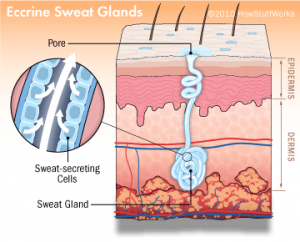 There are millions of sweat glands on the surface of your skin. These glands secrete large amounts of liquid when you’re perspiring (“sweating”). When that perspiration is evaporated, it helps to cool the skin, which in turn cools the blood and ultimately the rest of your body.
There are millions of sweat glands on the surface of your skin. These glands secrete large amounts of liquid when you’re perspiring (“sweating”). When that perspiration is evaporated, it helps to cool the skin, which in turn cools the blood and ultimately the rest of your body.- Moving air across your torso will remove any accumulated heat that remains there, and will help evacuate the perspiration that builds on your skin. The side benefit is that it will also help simulate a headwind, just like you’re actually riding on the real road.
- Proper ventilation will help circulate the air and help reduce increasing CO2 levels, as you exercise. If your room is in a completely closed-off space, you may want to ensure you have a way to vent the additional CO2 your body will produce by exercising. Keep a door open and that fan will help move that air through the open spaces and doorways outside of your workout area.
Unfit riders are more likely to suffer from inadequate cooling than those already in good health and fitness, but everyone needs cooling when they’re riding.
Prevention is Key
Some precautions you can take to keep cool and avoid overheating are:
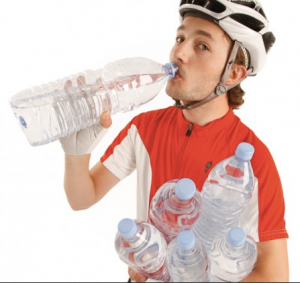
- Before a strenuous ride, drink plenty of water and other fluids. Always drink before you get “thirsty”, and at regular intervals. Remember though, excessively high levels of hydration will negatively hurt your performance. Drink enough, but don’t overdo it.
- Water is one important component, but as your rides get longer indoors you need to replenish crucial electrolytes that the body has lost. Make sure you’re consuming adequate amounts of electrolytic fluids or fruits and vegetables rich in electrolytes which also contain larger amounts of water.
- Don’t forget to drink plenty of fluids after the workout to replenish the fluids you’ve lost through perspiration. Your body has lost fluid, and it needs to be replaced. Progressive losses without replenishing the fluids can have dramatic and negative health and performance impacts.
- Periodically monitor your heart rate with a heart rate monitor (HRM) and make sure you keep your heart rate within your target heart rate zones.
- Manage the temperature and humidity in your environment. Increased temp and humidity could require that you decrease the intensity of your ride.
- Monitor your weight before and after each ride. If you have lost more than 3% of your total body weight before your next ride, skip the ride completely. For example, 3% of 175 pounds is about 5 pounds. If you’ve lost that amount of weight during your ride, make sure you drink fluids to replenish that weight, and don’t ride again until you have.
- Expose as much skin as possible to increase the surface area to cooling by evaporation of your perspiration.
- Last, and most-important! Recognize the early warning signs of insufficient cooling. These can include muscle cramping, excessive sweating, cold or clammy skin, unusually elevated body temperature, pale palor to the skin, dizziness, a weak or rapid pulse, shallow breathing, nausea or unexpected headache.
The Equipment
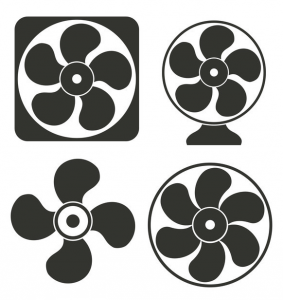
So with all of that mind-numbing science, math and anecdotal evidence, what fan should you get? Really, any fan will do, as long as it brings air into your space, across your body as you ride, and removes the heat produced by your workout.
There are dozens of models, styles and colors to choose from: floor fans, tall fans, box fans, window fans, ceiling fans and dozens of other choices. Check your local online or big-box retailer for options. You may even find good deals on fans during the Winter season, like buying a snowblower in July in the US.
Let your individual space dictate which fan makes the best sense.
Positioning the Fan
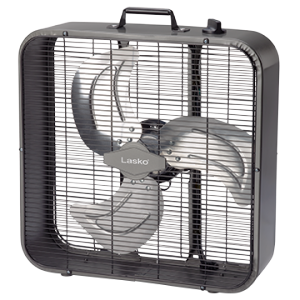
The best position for your fans is to have one aimed at you from the front, or obliquely in front of your bike. You want to simulate as close to a headwind as possible. You want to push the heat away from your body, front to rear if possible.
If you’re using just a single fan, place it in front of you and off to the side at about the 10-11 or 1-2 o’clock positions. The goal is to direct the air to flow over as much of your skin as possible, and from these positions you can get moving air on your face, chest, arms, shoulders, and legs.
Having the fan dead-center in the front of you will only blow across your narrowest profile, but that won’t cool you down as much as if you’re blowing slightly from the side. If you have a second fan, position it behind you so it’s blowing against your back. This is the next largest area of your body not being cooled by the fan (or fans) in the front.
Multiple fans is great, but may not always be possible, given your environment and your budget. It can also make your body and your workout space too cool.
Don’t forget to close those heater vents in your workout space! It’s an often-missed point, but you don’t want to be heating the room at the same time as you’re trying to cool it down with your fan(s).
If possible, cracking a window in your workout space could also help bring in some cool air from the outside, as well as keep the air clean and circulated while you’re working out. Just don’t forget to close that window when you’re done, or you might have a freezing house by the next morning!
New Fan Ideas
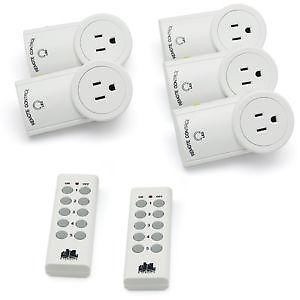
Some enterprising riders in the Zwfit community have invented some really creative ways to keep their environments cool, including remote-controlled outlets to turn on and off their fans, multiple fans with multiple remote controls, voice-controlled fans using their Amazon Echo IoT device, IFTTT recipes, and even automatic, terrain-controlled fans based on the environment visible in Zwift itself. Going downhill in Zwift? Fans speed up. Going up a steep hill? The fans slow down.
A Word of Warning
Warning: If you want to be creative with your fans, remember NEVER to use a dimmer switch meant for dimmable lighting fixtures for oscillating fan motors. You will overheat the motor by driving too much current through it, and could potentially start a fire of the wiring inside your walls. Don’t do it without a proper triac circuit. Here’s one to start with:
Good luck out there, and stay cool!

